1993 BUICK CENTURY brake
[x] Cancel search: brakePage 177 of 324
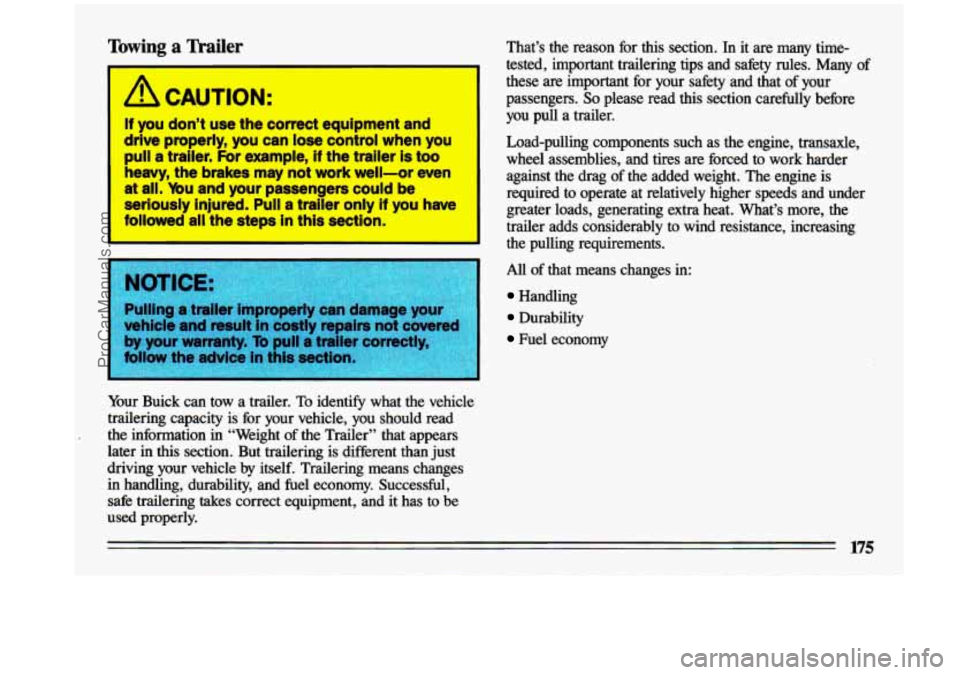
Towing a Trailer
A CAUTION:
If you don’t use the correct equipment and
drive properly, you can lose control when you
pull a traller. For example, If the trailer is too
heavy, the brakes may not work well--or wen
at all. Mu and your passengets could be
seriously Injured. Pull a trailer only if you have
followed all the steps in this section.
hicle and result
Your Buick can tow a trailer. To identify what the vehicle
trailering capacity is for your vehicle, you should read
the information in “Weight of the Trailer” that appears
later
in this section. But trailering is different than just
driving your vehicle
by itself. Trailering means changes
in handling, durability, and fuel economy. Successful,
safe trailering
takes correct equipment, and it has to be
used properly. That’s the reason for this section.
In it are many time-
tested, important trailering tips and safety rules. Many
of
these are important for your safety and that of your
passengers.
So please read this section carefully before
you pull a trailer.
Load-pulling components such as the engine, transaxle,
wheel assemblies, and tires are forced to work harder against the drag of the added weight. The engine is
required to operate at relatively higher speeds and under
greater loads, generating extra heat. What’s more, the
trailer adds considerably
to wind resistance, increasing
the pulling requirements.
All of that means changes in:
Handling
Durability
Fuel economy
175
ProCarManuals.com
Page 180 of 324

hitch. If you don’t seal them, deadly carbon monoxide
(CO) from your .exhaust can get into your vehicle
(see
“Carbon Monoxide” in the Index). Dirt and water can,
too.
hitches. Do not attach rental hitches or other bumper-
type hitches to them. Use only a frame-mounted hitch
that
does not attach to the bumper.
The bumpers on your vehicle are not intended for
Safety Chains
You should always attach chains between your vehicle
and your trailer. Cross the safety chains under the tongue
of the trailer so that the tongue will not drop to the road
if it becomes separated from the hitch. Instructions about
safety chains may
be provided by the hikh manufacturer
or by the trailer manufacturer. Follow the manufacturer’s
recommendation for attaching safety chains. Always leave
just enough slack
so you can turn with your rig. And,
never allow safety chains to drag on the ground.
Mer Brakes
Does your trailer have its own brakes? Be sure to read
and follow the instructions for the trailer brakes
so you’ll
be able to install, adjust and maintain them properly.
Don’t tap into your vehicle’s brake system if the trailer\
’s
brake system will use more than
0.02 cubic inch
(0.3 cc) of fluid from your vehicle’s master cylinder. If
it does, both braking systems won’t work well. You
could even lose your brakes.
Will the trailer brake parts take 3,000 psi (20 650 kPa)
of pressure? If not, the trailer brake system must not be
used with your vehicle.
If everything checks out this far, then make the brake
fluid tap at the upper rear master cylinder port.
But
don’t use copper tubing for this. If you do, it will bend
and finally break off. Use
steel brake tubing.
178
ProCarManuals.com
Page 181 of 324
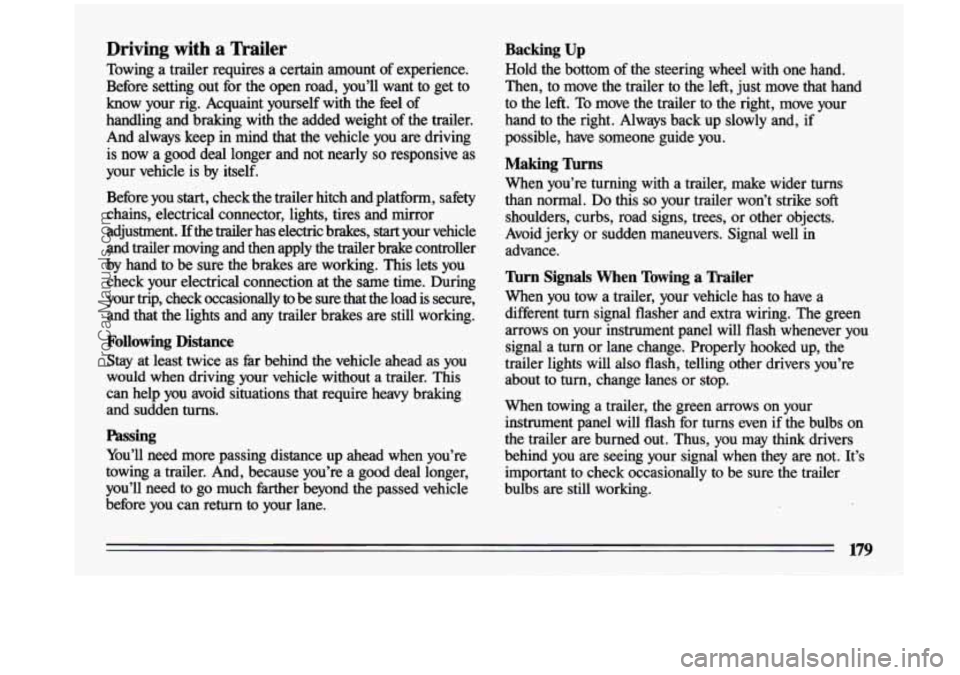
Driving with a Trailer
Towing a trailer requires a certain amount of experience.
Before setting out for the open road, you’ll want to get t\
o
know your rig. Acquaint yourself with the
feel of
handling and braking with the added weight of the trailer.
And always keep in mind that the vehicle you
are driving
is now a good deal longer and not nearly
so responsive as
your vehicle is by itself.
Before you
start, check the trailer hitch and platform, safety
chains, electrical connector, lights, tires and mirror
adjustment. If the trailer has electric brakes,
start your vehicle
and trailer moving and then apply the trailer brake controller \
by hand to be sure the brakes
are working. This lets you
check your electrical connection at the same time. During
your trip, check occasionally
to be sure that the load is secure,
and that the lights and any trailer brakes are still working.
Following Distance
Stay at least twice as fit, behind the vehicle ahead as you
would when driving your vehicle without a trailer. This
can help you avoid situations that require heavy braking
and sudden turns.
Passing
You’ll need more passing distance up ahead when you’re
towing
a trailer. And, because you’re a good deal longer,
you’ll
need to go much farther beyond the passed vehicle
before you can return to your lane.
Backing Up
Hold the bottom of the steering wheel with one hand.
Then, to move the trailer to the left, just move that hand
to the left.
To move the trailer to the right, move your
hand to the right. Always back up slowly and, if
possible, have someone guide you.
Making nrns
When you’re turning with a trailer, make wider turns
than normal.
Do this so your trailer won’t strike soft
shoulders, curbs, road signs, trees, or other objects.
Avoid jerky or sudden maneuvers. Signal well in
advance.
Turn Signals When Towing a Mler
When you tow a trailer, your vehicle has to have a
different turn signal flasher and extra wiring. The green arrows on your instrument panel will flash whenever you
signal a turn or lane change. Properly hooked up, the
trailer lights will also flash, telling other drivers you’re \
about to turn, change lanes or stop.
When towing a trailer, the green arrows on your instrument panel will flash for turns even if the bulbs on
the trailer are burned out. Thus, you may think drivers
behind you are seeing your signal when they are not. It’s
important to check occasionally to be sure the trailer
bulbs are still working.
179
ProCarManuals.com
Page 182 of 324
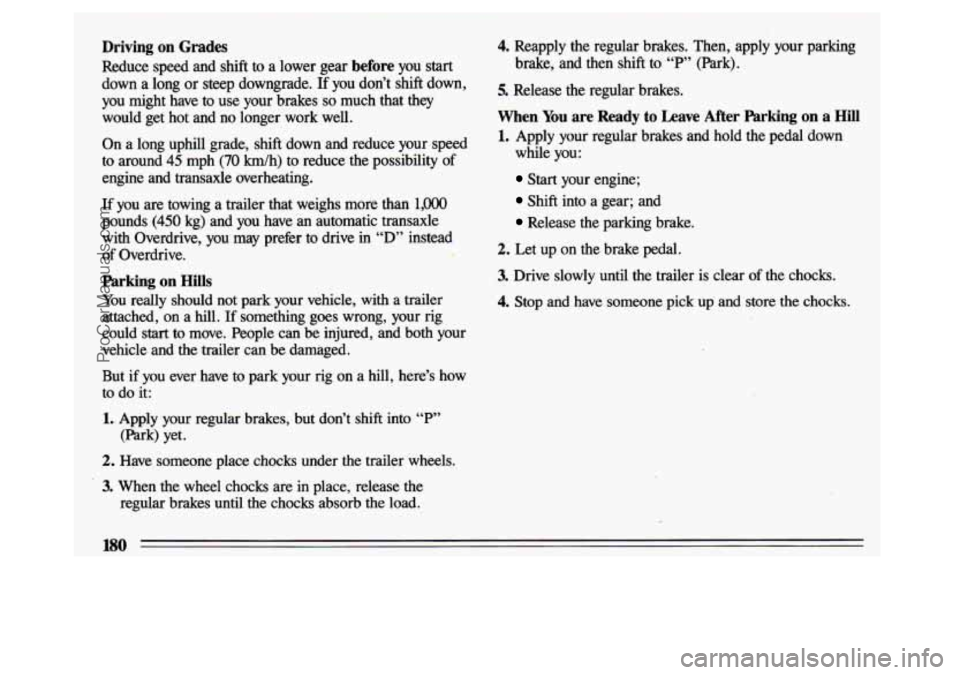
Driving on Grades
Reduce speed and shift to a lower gear before you start
down a long or steep downgrade. If you don’t shift down,
you might have to use your brakes
so much that they
would get hot and no longer work well.
On a long uphill grade, shift down and reduce your speed
to around
45 mph (70 Mh) to reduce the possibility of
engine and transaxle overheating.
If you are towing a trailer that weighs more than 1,OOO
pounds (450 kg) and you have an automatic transaxle
with Overdrive, you may prefer
to drive in “D” instead
of Overdrive.
Parking on Hills
You really should not park your vehicle, with a trailer
attached, on a hill.
If something goes wrong, your rig
could
start to move. People can be injured, and both your
vehicle and the trailer can be damaged.
But if you ever have to park your rig on a hill, here’s how
to do it:
1. Apply your regular brakes, but don’t shift into “P”
2. Have someone place chocks under the trailer wheels. (Park) yet.
3. When the wheel chocks
are in place, release the
regular brakes until the chocks absorb the load.
4. Reapply the regular brakes. Then, apply your parking
5. Release the regular brakes.
When You are Ready to Leave After Parking on a Hill
1. Apply your regular brakes and hold the pedal down
brake, and then shift to
“P” (Park).
while you:
Start your engine;
Shift into a gear; and
Release the parking brake.
2. Let up on the brake pedal.
3. Drive slowly until the trailer is clear of the chocks.
4. Stop and have someone pick up and store the chocks.
ProCarManuals.com
Page 183 of 324

Maintenance When Trailer Towing
Your vehicle will need service more often when you’re
pulling a trailer. See the Maintenance Schedule for more
on this. Things that are especially important in trailer
operation
are automatic transaxle fluid (don’t overfill),
engine oil, belt, cooling. system, and brake adjustment.
Each of these is covered in this manual, and the Index
‘will help you find them quickly.
If you’re trailering, it’s a
good idea to review these sections before you
start your trip.
Check periodically
to see that all hitch nuts and bolts are
tight.
181
ProCarManuals.com
Page 188 of 324

‘
A CAUTION:
Mu could be injured if the vehicles roll. Set
the parking brake firmly
on each vehicle. Put
an automatic transaxle
in “P” (Park) or a
manual transaxle
in “N” (Neutral). I
3. ”urn off the igni;,,n on both vehicles. lwLLL all .,hts
that aren’t needed, and radios. This will avoid sparla
and help save both batteries. And it could save your radio!
If you leave your radio OI,, it could be badl,
4. Open the hoods and locate the batteries.
I 1
A CAUTION:
An electric fan can start up even when the
engine
is not running and can Injure you. Keep
hands, clothing and tools
away from any
underhood electric fan.
I
Find the positive (+) and negative (-) terminals on
each battery.
-
/1 CAUTION:
Using a match near a battery can cause
battery gas to explode. People have been hurt
doing this, and some have been blinded.
Use a
flashlight If you need more light.
Be sure the battery has enough water. Mu
don’t need to add water to the Delco
Freedom@ battery installed
in every new GM
vehicle. But if a battery has filler caps, be sure
the
right amount of fluid is there. If it is low,
add water to take care of that first. It you don’t,
explosive gas could be present.
Battery
fluid contains acid that can burn you.
Don’t get it on you. Ifyou accidentally get it in
your
eyes or on your skin, flush the place with
water and get medical help immediately.
-
5. Check that the jumper cables don’t have loose or missing insulation.
If they do, you could get a shock.
The vehicles could be damaged, too.
186
ProCarManuals.com
Page 193 of 324
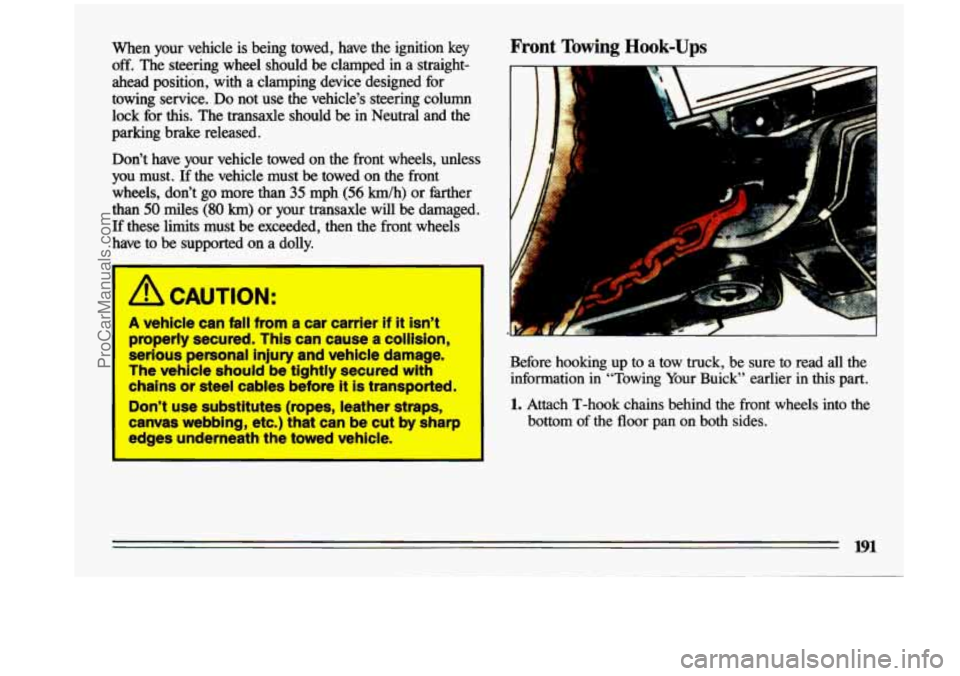
when your vehicle is being towed, have the ignition key Front Towing Hook-Ups
off. The steering wheel should be clamped in a straight-
ahead position, with a clamping device designed for
towing service.
Do not use the vehicle’s steering column
lock for
this. The transaxle should be in Neutral and the
parking brake released.
I
Don’t have your vehicle towed on the front wheels, unless
you must. If the vehicle must be towed on the front
wheels, don’t go more than
35 mph (56 km/h) or farther
than
50 miles (80 km) or your transaxle will be damaged.
If these limits must be exceeded, then the front wheels
have
to be supported on a dolly.
1
I
&!, CAUTION:
A vehicle can fall from a car carrier if It Isn’t
properly secured.
This can cause a colllsion,
serious personal injury and vehicle damage.
The vehicle should be tightly secured with Before hooking up to a tow truck, be sure to read all the
chains or steel cables before it is transported. information in “Towing Your Buick” earlier in this part.
Don’t use substitutes (ropes, leather straps, I
1. Attach T-hook chains behind the front wheels into the
canvas webbing, etc.) that can be cut by sharp bottom of the floor pan on both sides.
edges underneath the towed vehicle. I
191
ProCarManuals.com
Page 207 of 324
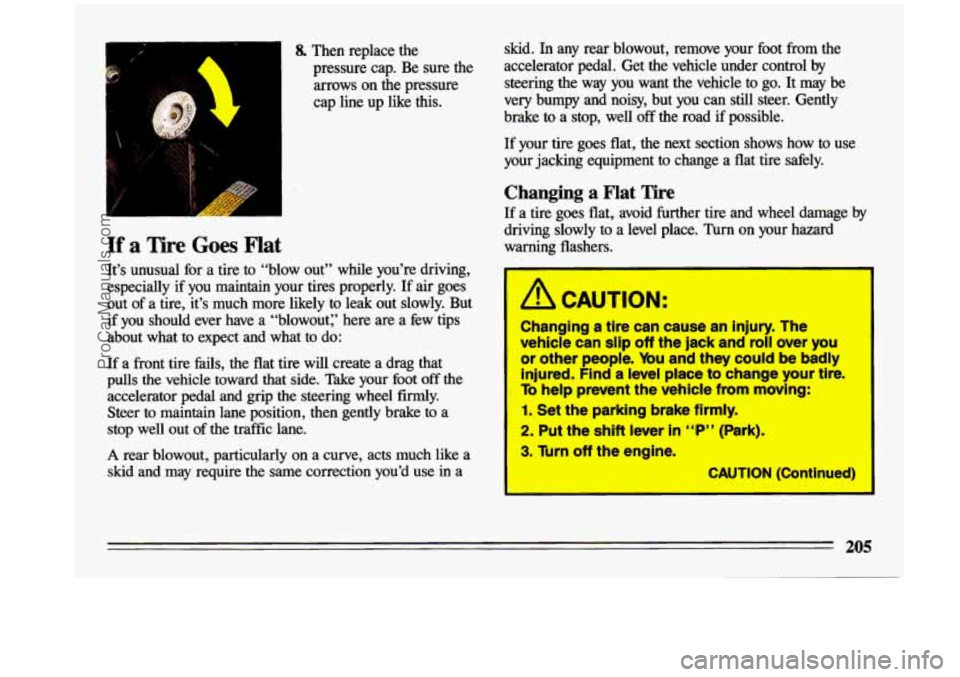
8. Then replace the pressure cap. Be sure
the
arrows on the pressure
cap line up like this.
If a Tire Goes Flat
It’s unusual for a tire to “blow out” while you’re driving,
especially if you maintain your tires properly. If air
goes
out of a tire, it’s much more likely to leak out slowly. But
if you should ever have a “blowout:’ here are a few tips
about what to expect and what to do:
If a front tire fails, the flat tire will create a drag that
pulls
the vehicle toward that side. Take your foot off the
accelerator pedal and grip
the steering wheel firmly.
Steer to maintain lane position, then gently brake to a
stop well out of the traffic lane.
A rear blowout, particularly on a curve, acts much like a
skid and may require the same correction you’d use in a skid.
In any rear blowout, remove your foot from the
accelerator pedal. Get the vehicle under control by
steering the way you want the vehicle
to go. It may be
very bumpy and noisy, but you can still steer. Gently brake
to a stop, well off the road if possible.
If your tire goes flat; the next section shows how to use
your jacking equipment to change a flat tire safely.
Changing a Flat Tire
If a tire goes flat, avoid further tire and wheel damage ~y
driving slowly to a level place. Turn on your hazard
warning flashers.
A CAUTION:
Changing a tire can cause an injury. The vehicle can slip
off the jack and roll over you
or other people. You and they could be badly injured. Find a level place to change your tire.
To help prevent the vehicle from moving:
1. Set the parking brake firmly.
2. Put the shift lever in “P” (Park).
3. Turn off the engine.
CAUTION (Continued)
205
ProCarManuals.com